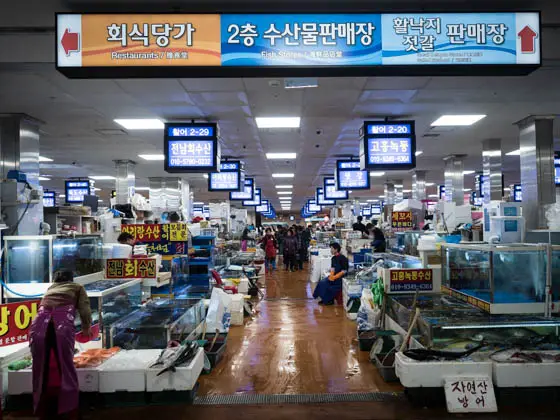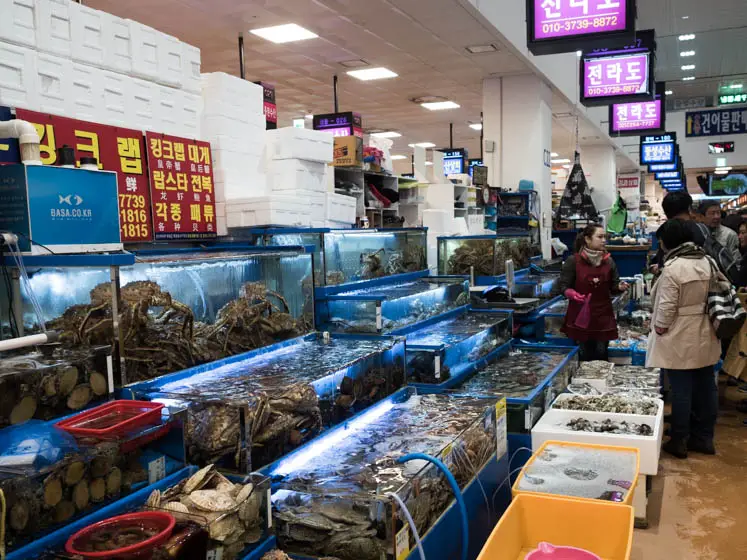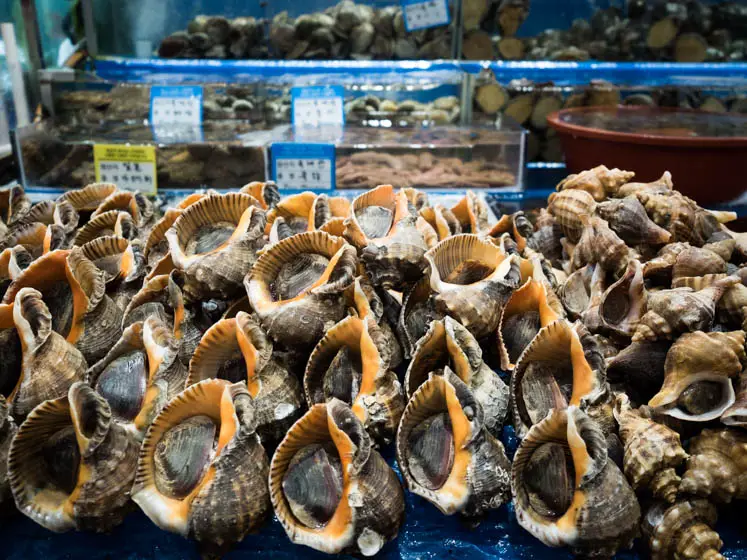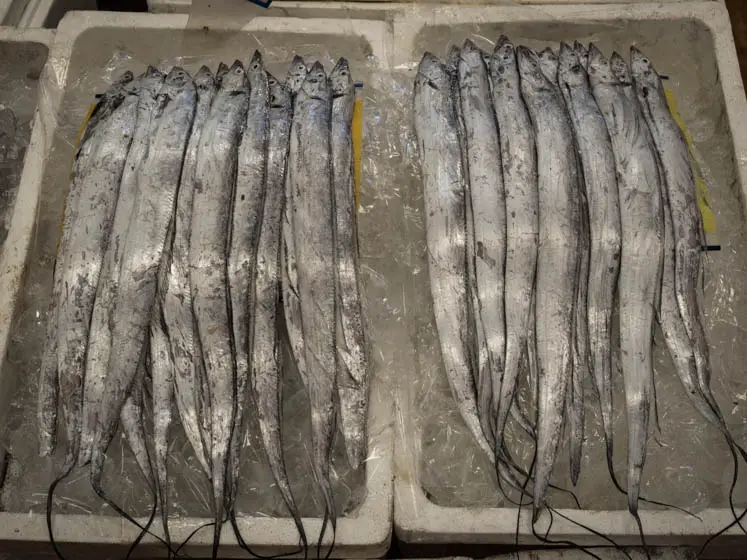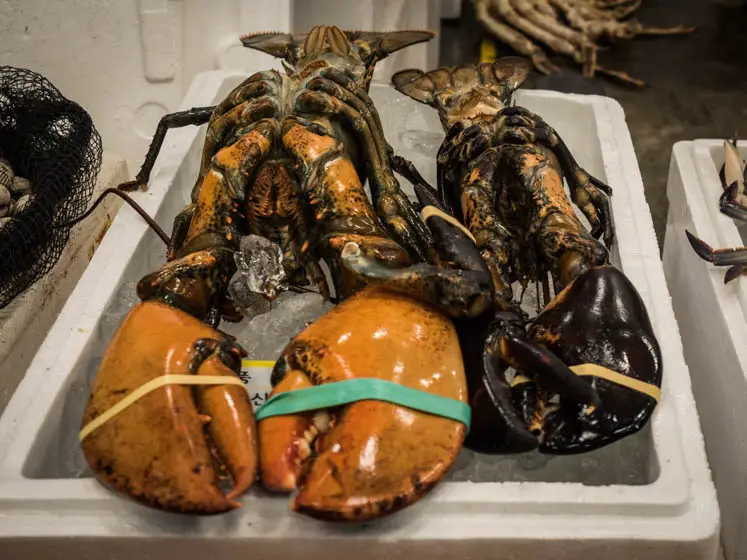As an Amazon Associate I earn from qualifying purchases. Please read the disclaimer for more info.
Unlike some seafood markets we have visited, Seoul’s Noryangjin Fisheries Wholesale Market, more commonly referred to as Noryangjin Fish Market, is extremely very well organised, and set up for both the wholesale and retail customers.
We were able to walk up and down the wide aisles looking at the stalls in relative comfort, without getting in the way of normal sales activities, and without being soaked by some of the water being splashed around, which is one of the inevitable consequences of visiting fish markets.
This Seoul market had all the typical seafood varieties common in this region, and they also had a number of species I hadn’t seen before. Unfortunately, as my Korean is non-existent, and the vendors with spoke little English, and/or were too busy, I didn’t get the chance to find out what they were.
Some of the vendors did, however, have the ability to ask us to buy their seafood so it could be cooked for us at one of the upstairs restaurants. If I hadn’t read that this was an option here, it would have become fairly confusing early on.
And as one of my pastimes is eating at local markets of any type, the chance to choose and buy the seafood ourselves to be cooked for our breakfast by one of the onsite chefs was an opportunity I wasn’t going to miss.
This was, I was hoping, going to be the highlight of our visit to this famous Korean seafood market, and I cover the process, and the results, below.
But before doing so, we wanted to have a good look at the Noryangyin Fisheries Wholesale Market, and set out to do so.
Noryangjin Fisheries Wholesale Market
Although Noryangjin Fish Market has been in operation since 1971, the current location, which runs along the Han River, is quite new, with the vendors occupying this space since 2016. The multi-level complex has all the requirements of a modern seafood market, with the main market area with more than 700 stalls on the ground floor, shops selling dried fish, snack bars and cafes on the first floor, site restaurants on the second floor, with an outdoor deck on the third.
It is one of South Korea‘s biggest markets.
And as for being a quality place for buying seafood in Seoul, the variety of stock available covered all the usual suspects, including oysters, clams, prawns, anchovies, sea snails, lobster, salmon, mackerel, tuna, mussels, sea urchin, sting rays, abalone, and some of the biggest king crabs I’ve seen.
The difficult part was choosing what to have for breakfast!

Now that’s a crab! This vendor was very friendly and insisted we take a number of photos. We ended up buying our seafood to have for breakfast from her so I guess the friendliness paid off.
Eating at Noryangjin Fish Market Restaurants
Before we bought our seafood to have cooked for us, we went upstairs to the second floor to have a look at the range of restaurants so we could choose one to cook our “catch”. We narrowed it down to a couple that seemed busy, because I guess, we figured, they must be doing something right!
Turns out that we didn’t need to choose one, as the vendors are usually aligned to a particular restaurant, which makes life a little easier.
Choosing the seafood was fairly straight-forward as most of the vendors have a great range, meaning we could buy all the seafood from one vendor, and bargain down the price a little.
After we made our choices, we were whisked upstairs to the aligned restaurant, where we were taken to a private booth. We were presented with a menu to choose the sides we wanted such as soup, rice, or noodles, as well as drinks including alcohol such as soju, but it was a little bit too early to be hitting the local fermented rice wine.
The waitress then asked how we wanted our dishes cooked, or uncooked as in the oysters.
The results were mixed.
The scallops and lobster were cooked very well and tasted delicious, however for some reason the chef had some trouble opening the oysters. I’m not sure why. Oysters aren’t difficult to shuck, and especially within a seafood restaurant at South Korea’s biggest seafood market, and within a culture of enjoying raw seafood (hoe style).
Tip: Maybe buy oysters already shucked.
If you still want to eat seafood at the market, but don’t feel like buying the seafood yourself, then ordering off a menu is not only possible, but probably a cheaper option. But that wouldn’t be as much fun would it.?

The butchering of the oyster shells. The oysters still tasted fine, but couldn’t be slurped down with the liquid as the shells were either not opened properly or had some bits of the shells floating over the oyster.
Noryangjin Fish Market Opening Hours
Auctions
Auction start at 1.00am and go through to the early hours of the morning.
Auctions do not take place Sundays or over key public holidays.
General Market
Whilst the market itself is open 24 hours a day, the general market is open between 1.00am to 10.00pm.
How to get to Noryangjin Fish Market
The easiest way to get to the market is to catch the subway to along line 1 to Noryangjin Station, where you will need to use the overpass to cross the tracks. There are signs in English showing the way.
Car parking is available on-site.
Tips for visiting this famous Seoul Market
- As Noryangjin Fisheries Wholesale Market is a wet market, wear clothing and footwear that you don’t mind getting wet
- There is no need to rush through. The vendors will, by and large, leave you to wander through at your own pace, and don’t mind photos being taken, and will often place themselves into the photo
- A level of bargaining is expected, especially when buying a few items. The vendors will use a calculator to give you the prices.
- Entry is free
- There is actually no need to buy your own seafood to be cooked in one of the restaurants. You can simply order straight from the menu, if buying your own isn’t something you want to do.
Enjoy this story on Noryangjin Fisheries Wholesale Market? Then sign up to have new posts sent straight to your inbox.

